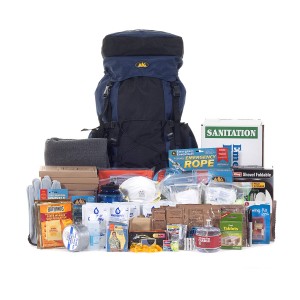By Angie Sullivan

Is your family ready for an emergency evacuation? Having backpacks or other easily-carried supply packs for each member of your family will help you evacuate with more confidence and less anxiety. Are you unsure about what to include in an emergency kit or if the ones you have are complete? Using our
Emergency Kit Checklist, let’s review the basics.
Backpack or Bag
First, a kit needs to be portable, so use a good backpack or duffle bag. Consider who will carry the pack and make sure they can carry it when everything is packed inside. Also, make sure you store these kits close to an exit. No one wants to dig through the basement when they need to get out the door quickly in an emergency. Backpacks are great since they keep both hands free.
Food and Water
You can use water bottles,
water pouches, or water boxes to store water in your kit. Water purification tablets make a useful addition, as well. Once you have a sufficient supply of water, you’re ready to store some food. You can start with items already in your pantry Do you have granola bars, beef jerky, soup, cans of tuna, or fruit snacks? Any items that store for a long time are perfect. If you have cans that need to be opened, make sure you have a can opener. After that, you may need to purchase additional emergency food items.
MREs (Meals Ready to Eat) are a great choice— they come in many different flavors and can be eaten straight from the pouch.
High calorie food bars are lightweight and provide the calories needed to sustain life. Hot chocolate and drink mix packets will help make the water, which might be a little stale, much more palatable. Hard candy is another great addition. It keeps for years and can provide comfort in an emergency. Store as much food and water as space and your strength will allow. Make sure you check your food and water at least once a year and rotate it as needed.
First Aid and Sanitation
Purchase or put together a basic
first aid kit. This kit might include bandages, antibiotic ointment, cleansing wipes, pain medications, and a small first aid pamphlet. Consider adding tweezers, safety pins, and any medication family members require on a daily basis. Then add some sanitation supplies to our kit. I don’t know about you, but having toilet paper, toothbrush and toothpaste, wet wipes, hand sanitizer, soap, comb/brush, lip balm, and deodorant are must-haves on my list. Assess the hygienic needs of each family member. What would each need? Just take note of what you need to get ready in the morning (bare minimum, of course) and pack those items. Dollar stores are great places to pick up these items.
Clothing & Warmth
I know I would be miserable in an emergency without a change or two of clothing , so having a few changes are necessary for my family. Consider having extra underwear, clothing that can be layered, and large zip-top bags to keep them dry in case of inclement weather. If you have small children, you will need to adjust their packs seasonally to make sure the clothing will still fit them. You also need to pack a few cold weather items.
Ponchos will keep off the rain, emergency bags and blankets will reflect body heat, and hand warmers will keep your fingers toasty.
Fuel and Mess Kit
If you’ve stored food that needs to be heated, you’ll want to store a mess kit, stove, and fuel. If you don’t plan on heating food, choose items that don’t need to be heated to be eaten—like food calorie bars. MRE’s can be purchased with “heaters,” little pouches that use a chemical reaction to heat the food.
Tools
Consider a multifunction tool with scissors, a can opener, and other tools that may come in handy. Pack flashlights (preferably LED), and include extra batteries. Also consider adding candles, matches, duct tape, whistles, a compass, garbage bags, zip-top baggies, tarps, a tent if possible, battery-powered or hand-crank radio, and rope. Don’t forget some pencils and paper, cash and coins. Not all members of the family need to pack all these items, but someone needs to.
Sleeping Arrangements
Make sleeping arrangements for each person. If you’ve got a tent, great, but if not, a tarp can be rigged up to provide cover for sleeping bags or bedrolls for your family. Again, emergency bags or blankets—though not comfortable in the traditional sense—will hold in lots of body heat, take up little space, and are extremely lightweight! As you put your kit together, remember to keep it as lightweight as possible. It’s for your basic needs if you have to leave home in an emergency . Your family’s kits don’t have to cost a lot of money or take up a lot of space. Try to keep them close to an exit in your home and make sure each member of the family knows where they are stored. For a more comprehensive list of emergency kit items, view our
Emergency Kit Checklist.


1 comment
DOUGLAS K HYER
WHEN IN AN EMERGENCY-FIND AN EAGLE SCOUT TO LEAD YOU! WE ARE ALWAYS "PREPARED".